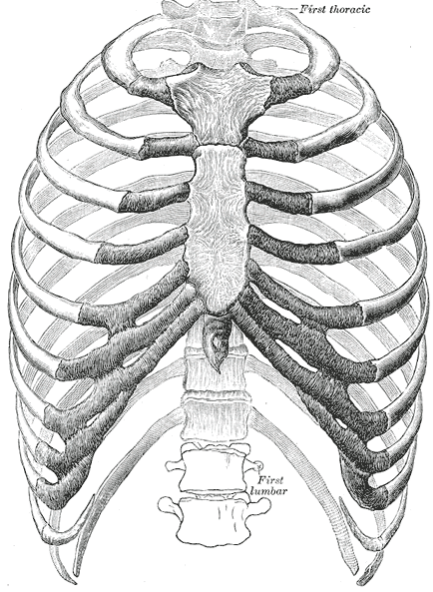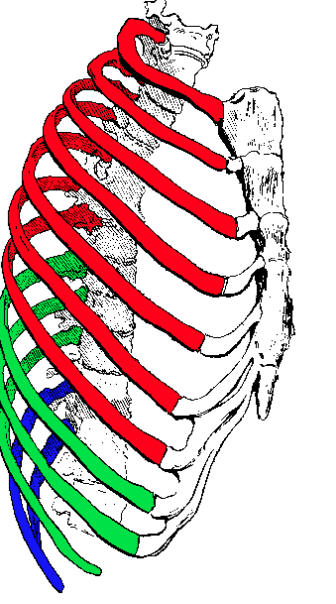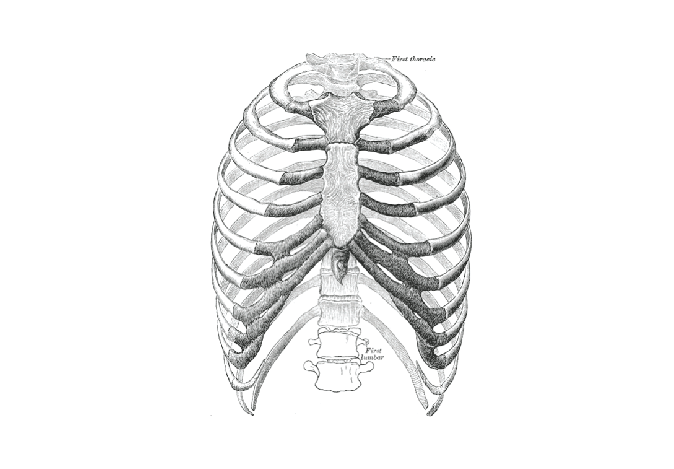What structures are you using when you breathe? If you ask a bunch of flute players this question, the typical answers are lungs, diaphragm, mouth, and abdominal muscles. All of these are correct answers, but there is an important group that is often excluded – RIBS!

How many ribs do you have?
Answer: A lot. This is a multi-purpose answer which also works for “How many vertebrae do you have?” and “How many sensory receptors do you have in the soles of your feet?” The specific answer to this question is that we have 24 ribs—12 on each side. All 24 ribs attach to the spine in the back. Ribs 1-7 on each side are attached directly to the sternum through costal cartilage. Ribs 8-10 attach to the cartilage of rib 7, which then connects to the sternum. Ribs 11 and 12 are called floating ribs because they do not attach in the front. Many people are aware of the lower ribs, but are somewhat fuzzy about where their upper ribs are located. The first rib that you can actually palpate at its connection to the sternum is rib 2. Rib 1 is behind the collarbone.

Rib Shapes
Both the size and the shape of the ribs changes as you move from the top to bottom. The smallest ribs on the top are more curved, like a letter C shape. As the ribs get progressively bigger, the shape changes into more of a flat oval shape. When looking from the side, notice that the ribs are higher in the back than they are in the front. They are not parallel to the floor, although we can certainly make it feel like they are. All you have to do is over-arch your lower back and thrust your chest forward. Anybody have lower back pain and trouble making those long phrases?
What do ribs actually do for breathing?
When we inhale, the ribs move up and out, like the handles of a bucket. When we exhale, the ribs move back down and in. Place your thumbs in your arm pits and let your fingers rest on top of your sternum. As you breathe in, notice that your fingers are moving slightly apart. This is because your ribs are moving underneath, up and out during inhalation. As you exhale, your ribs come down and in and fingers move slightly closer together.
What area of body real estate lives inside the ribs? The lungs! Lungs are not muscles and cannot move themselves. As the ribs move up and out, the diaphragm is moving down. The lung tissue moves along with the rib and diaphragm movement. Together these movements create a bigger space in the thoracic cavity. Air is a gas, which means it moves from areas of high pressure to areas of low pressure. As the space inside gets bigger, the pressure is lower inside, so air rushes in. When exhaling, as the ribs and diaphragm move back to their original starting position, the size of the space gets smaller and the pressure becomes higher inside, so air moves out. An easy way to remember how gases work is to think of a small classroom with 100 kindergarteners inside. This is a high pressure situation, right? To reduce the pressure, you open the door (make the space bigger) and 25 of them run out. This is movement from high to low pressure—voila!
If you’ve ever had a fractured or cracked rib, you know how terribly painful that be during breathing. Even costochondritis, an inflammation of the costal cartilage, can be exceedingly painful—I had this once a few winters ago and it felt like somebody was stabbing a knife in between my ribs when I tried to breathe.
Rib mover muscles
There are two sets of muscles that nestle in between the ribs themselves, internal and external intercostal (in between ribs). Catchy name, right? One set pulls a rib up towards its upper neighbor and the other set pulls it back down. The diaphragm attaches to the bottom edge of ribs and the sternum. There are other muscles that attach to ribs —some are abdominals, some are arm movers, some are leg movers. I could include a bunch of anatomical information about specific muscles here, but not everyone wants or needs that level of detail. The main idea is that anything that prevents your ribs from moving at the right time is going to impact your breathing. What might prevent ribs from moving? If your arm structure is pulled down onto your ribs, this can prevent free, easy movement of the upper ribs, especially. If you are constantly engaging your abdominal muscles, these pull the ribs down, which is the opposite of what we need ribs to do during inhalation. We want the ribs to be able to move in the right direction at the right time.
Cage?
Notice that the word “rib cage” have not appeared in this article. A cage is something that is rigid and designed not to move. “Rib cage” implies that ribs are rigid and not moveable, when in reality, ribs are mobile and are vital components of our respiratory system.
Spend some time getting to know all 24 of your ribs. They are easily palpated, with the exception of the top rib. You might be surprised with what happens to your breathing when you learn to monitor the consistent movement of ribs during both inhalation and exhalation.


[…] The Flute Examiner (Kelly Wilson): Why We Should Love Our Ribs […]